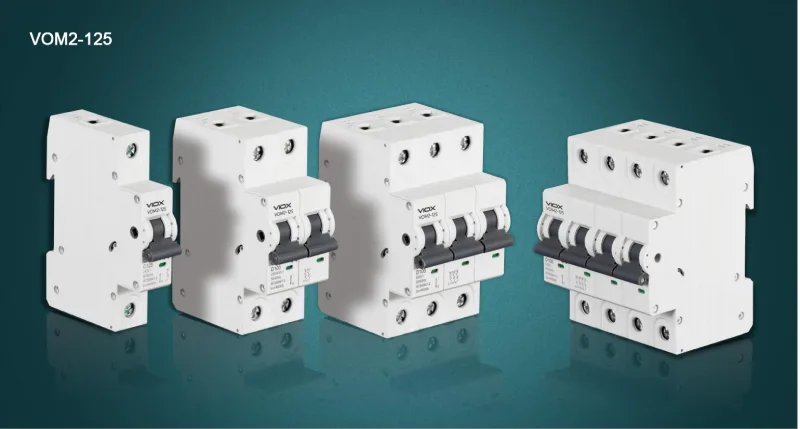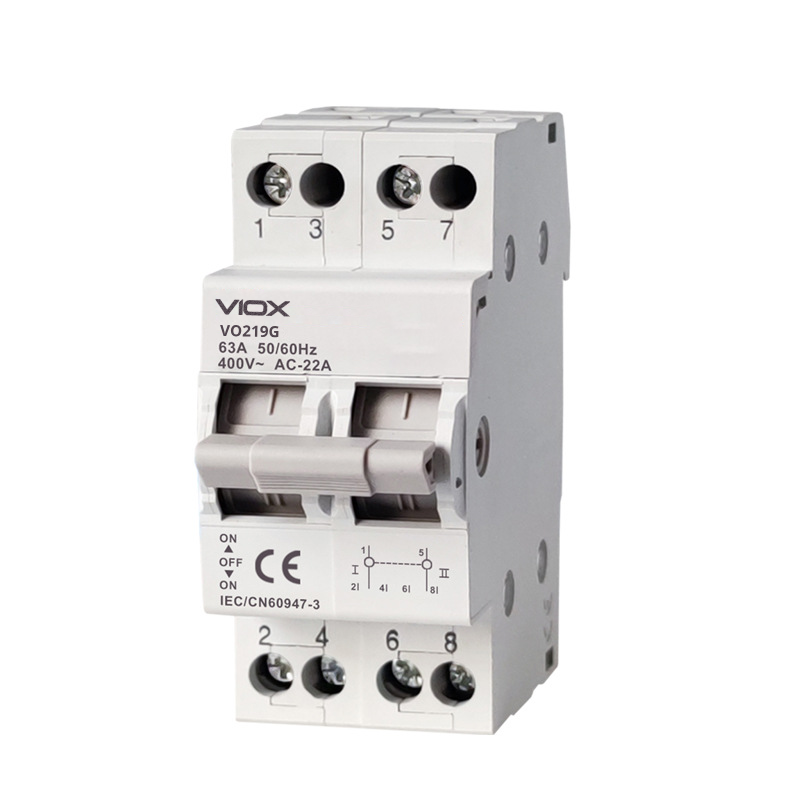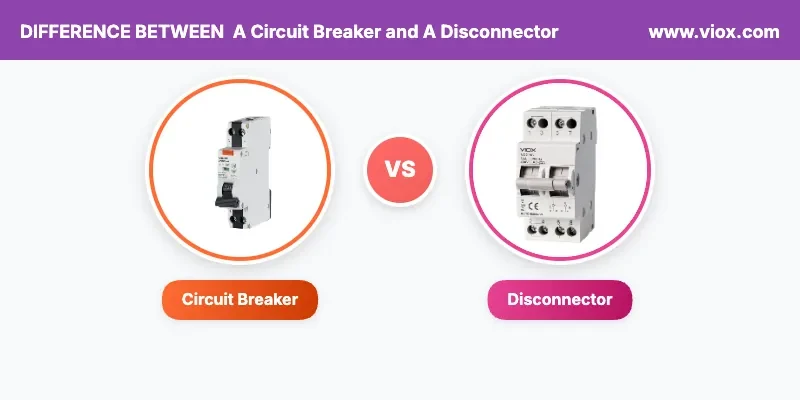Doğrudan Cevap: A circuit breaker automatically interrupts electrical current during fault conditions and can operate under load, while a disconnector (isolator) provides visible isolation for maintenance purposes and should only operate when circuits are de-energized. Circuit breakers offer protection; disconnectors provide isolation.
Understanding the difference between circuit breakers and disconnectors is critical for electrical safety, proper system design, and code compliance. Both devices control electrical circuits, but they serve fundamentally different purposes in electrical systems.
Key Definitions: Circuit Breakers vs Disconnectors
Devre Kesici Nedir?

A devre kesici is an automatic electrical switching device designed to protect electrical circuits by interrupting current flow when fault conditions occur. It can make, carry, and break currents under normal and abnormal (fault) conditions.
Temel özellikler:
- Automatic operation during faults
- Arc extinction capability
- Can operate under full load conditions
- Provides overcurrent and short-circuit protection
- Resettable after tripping
What is a Disconnector (Isolator)?

A disconnector, also called an isolator, is a mechanical switching device that provides isolation of circuits for maintenance and safety purposes. It creates a visible gap between electrical contacts when open.
Temel özellikler:
- Sadece manuel çalışma
- Visible isolation gap
- Operates only when circuits are de-energized
- No fault interruption capability
- Prevents accidental energization during maintenance
Kapsamlı Karşılaştırma Tablosu
| Özellik | Devre Kesici | Disconnector (Isolator) |
|---|---|---|
| Birincil Amaç | Protection against faults | Isolation for maintenance |
| Operasyon | Otomatik ve manuel | Sadece manuel |
| Ark Yok Oluşu | Yes (SF6, vacuum, oil, air) | No – minimal or none |
| Load Breaking | Yes – full load capability | No – load-free operation only |
| Fault Current | Interrupts fault currents | Arıza akımları kesilemez |
| Visible Gap | Gerekli değil | Required for safety |
| Standartlar | IEC 62271-100, IEEE C37 | IEC 62271-102, IEEE C37.30 |
| Typical Voltage | All levels (LV to EHV) | Medium to high voltage |
| Kurulum Maliyeti | Daha yüksek | Daha düşük |
| Bakım | Complex mechanism | Simple mechanism |
Critical Differences Explained
1. Fault Interruption Capability
Devre Kesiciler:
- Designed to interrupt fault currents up to their rated capacity
- Use arc extinction media (SF6 gas, vacuum, oil, or air)
- Can break currents many times their normal rating during faults
- Essential for system protection
Disconnectors:
- Cannot interrupt fault currents safely
- May create dangerous arcing if opened under load
- Used only after circuit is de-energized by other means
- Primarily isolation, not interruption
2. Operating Conditions
Devre Kesiciler:
- Operate under normal and fault conditions
- Can make and break full load currents
- Function automatically during abnormal conditions
- Suitable for frequent operation
Disconnectors:
- Operate only under no-load or minimal load conditions
- Require circuit to be de-energized before operation
- Manual operation with visible position indication
- Infrequent operation for maintenance purposes
⚠ ️ Güvenlik Uyarısı: Never operate a disconnector under load conditions. This can cause dangerous arcing, equipment damage, and severe safety hazards.
Uygulamalar ve Kullanım Örnekleri
When to Use Circuit Breakers
Endüstriyel Uygulamalar:
- Motor koruma ve kontrolü
- Feeder protection in distribution systems
- Jeneratör ve trafo koruması
- Fault current interruption in power systems
Ticari Uygulamalar:
- Main service disconnect protection
- Dal devre koruması
- Load center applications
- Automatic transfer switch integration
Konut Uygulamaları:
- Ana elektrik panosu koruması
- Bireysel devre koruması
- GFCI and AFCI protection
- Whole-house surge protection integration
When to Use Disconnectors
Substation Applications:
- Bus sectionalizing
- Equipment isolation for maintenance
- Visible isolation requirements
- Line switching in transmission systems
Endüstriyel Uygulamalar:
- Motor disconnect switches
- Ekipman izolasyonu
- Maintenance safety isolation
- Emergency disconnection points
Maintenance Applications:
- Creating safe work zones
- Kilitleme/etiketleme prosedürleri
- Equipment servicing isolation
- Visual confirmation of de-energization
Selection Criteria and Expert Guidelines
Choosing Circuit Breakers
Key Factors to Consider:
- Rated Current: Must exceed normal operating current
- Breaking Capacity: Must exceed maximum fault current
- Voltage Rating: Must match or exceed system voltage
- Type of Load: Motor, resistive, capacitive considerations
- Environmental Conditions: Indoor/outdoor, temperature, contamination
Uzman İpucu: Always consult fault current studies when selecting circuit breakers. The breaking capacity must exceed the maximum available fault current at the installation point.
Choosing Disconnectors
Key Factors to Consider:
- Isolation Requirements: Visible gap specifications
- Mechanical Endurance: Expected operating cycles
- Environmental Rating: Weather resistance for outdoor units
- Interlocking Requirements: Safety interlocks with other equipment
- Accessibility: Ease of operation and maintenance access
Uzman İpucu: Specify disconnectors with auxiliary contacts for remote indication of position. This enhances safety and operational awareness.
Güvenlik ve Kod Uyumluluğu
Ulusal Elektrik Kodu (NEC) Gereksinimleri
Madde 240-Aşırı Akım Koruması:
- Circuit breakers must provide overcurrent protection
- Proper coordination with upstream protective devices
- Arc-fault and ground-fault protection requirements
Madde 430-Motorlar:
- Motor branch-circuit short-circuit protection
- Motor disconnect requirements within sight
- Combination motor controllers specifications
IEEE Standards Compliance
IEEE C37 Series Standards:
- C37.04: Standard for circuit breaker rating structure
- C37.06: AC high-voltage circuit breaker standards
- C37.30: Disconnecting switch standards
Temel Uyumluluk Noktaları:
- Proper application within ratings
- Environmental qualification testing
- Gerektiğinde sismik yeterlilik
- Electromagnetic compatibility requirements
️ ️ Profesyonel Öneri: Always consult with licensed electrical engineers for medium and high-voltage applications. Improper selection can result in catastrophic failures.
Kurulum ve Bakımla İlgili Hususlar
Circuit Breaker Installation Best Practices
Step-by-Step Installation Process:
- Kurulum Öncesi Planlama
- Verify electrical ratings match application
- Confirm available fault current levels
- Çevresel koşulları kontrol edin
- Physical Installation
- Follow manufacturer torque specifications
- Ensure proper conductor termination
- Verify mechanical clearances
- Test ve Devreye Alma
- Primary injection testing for protection relays
- Mekanik operasyon testi
- Timing and contact resistance testing
Disconnector Installation Best Practices
Step-by-Step Installation Process:
- Site Preparation
- Verify foundation requirements
- Check clearance to live parts
- Ensure accessibility for operation
- Mekanik Kurulum
- Follow manufacturer alignment procedures
- Verify operating mechanism function
- Test interlocking systems
- Elektrik Bağlantısı
- Use proper conductor termination methods
- Apply specified contact pressure
- Verify auxiliary circuit connections
Sık Karşılaşılan Sorunları Giderme
Circuit Breaker Problems
Symptom: Breaker Won’t Close
- Check control power supply
- Verify spring charging mechanism
- Inspect mechanical interlocks
- Test closing coil continuity
Symptom: Nuisance Tripping
- Analyze load current profiles
- Gevşek bağlantıları kontrol edin
- Verify proper time-current coordination
- Çevresel faktörleri göz önünde bulundurun
Disconnector Problems
Symptom: Difficult Operation
- Inspect operating mechanism lubrication
- Mekanik bağlanmayı kontrol edin
- Verify proper adjustment
- Examine contact wear
Symptom: Poor Contact Performance
- Check contact pressure settings
- Inspect for contamination
- Verify proper alignment
- Consider contact material compatibility
Hızlı Başvuru Kılavuzu
Circuit Breaker Quick Facts
- Birincil İşlev: Automatic fault protection
- Can Operate: Under load and fault conditions
- Ark Sönmesi: Yes – multiple technologies available
- Tipik Uygulamalar: Protection and switching
- Kod Referansları: NEC Article 240, IEEE C37 series
Disconnector Quick Facts
- Birincil İşlev: Isolation for maintenance
- Can Operate: Only when de-energized
- Ark Sönmesi: No – relies on air gap
- Tipik Uygulamalar: Isolation and visible disconnect
- Kod Referansları: NEC Article 430.102, IEEE C37.30
Sıkça Sorulan Sorular
Can a disconnector replace a circuit breaker?
No, a disconnector cannot replace a circuit breaker. Disconnectors lack fault interruption capability and cannot provide overcurrent protection required by electrical codes.
When should both devices be used together?
Both devices are commonly used together in medium and high-voltage applications where protection (circuit breaker) and isolation (disconnector) functions are both required for safe operation and maintenance.
What happens if you operate a disconnector under load?
Operating a disconnector under load can cause dangerous arcing, equipment damage, fire hazards, and potential injury. This practice violates safety codes and manufacturer recommendations.
Kombinasyon cihazları mevcut mu?
Yes, some manufacturers offer combination circuit breaker-disconnector devices, particularly for motor applications. These devices provide both protection and visible isolation in a single unit.
How do you determine the proper sequence of operation?
For systems with both devices, always operate the circuit breaker first to interrupt current, then operate the disconnector for isolation. Reverse this sequence when re-energizing.
What are the typical maintenance intervals?
Circuit breakers typically require maintenance every 5-10 years depending on application and manufacturer recommendations. Disconnectors may require maintenance every 10-15 years due to their simpler mechanisms.
Can disconnectors be automated?
Yes, disconnectors can be equipped with motor operators for remote control, but they still should only operate under no-load conditions and typically require additional safety interlocks.
What are the different types of circuit breaker technologies?
Main types include air circuit breakers (ACB), vacuum circuit breakers (VCB), SF6 gas circuit breakers, and oil circuit breakers, each suited for different voltage levels and applications.
Profesyonel Tavsiye: For any electrical installation or modification involving circuit breakers or disconnectors, consult with a licensed electrical engineer or certified electrician. Proper application of these devices is critical for safety, code compliance, and reliable operation.
Hatırlamak: Circuit breakers protect your electrical system from faults, while disconnectors protect you during maintenance. Both are essential components of safe electrical design, but they serve distinctly different purposes and must never be confused or misapplied.


